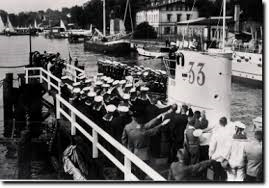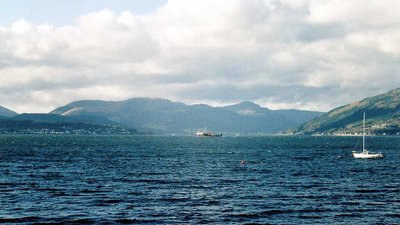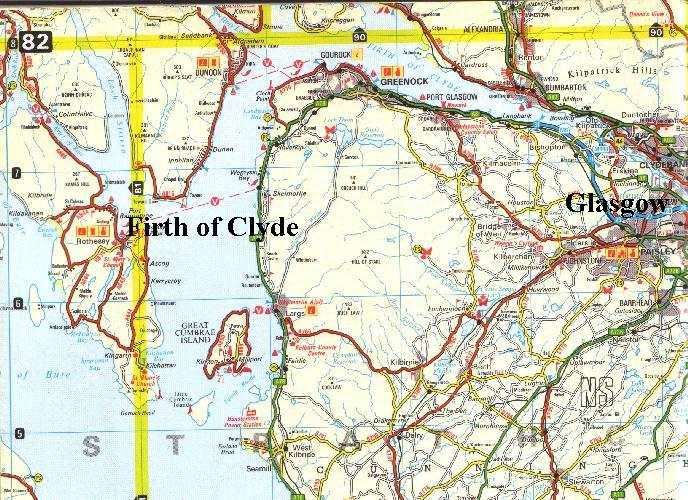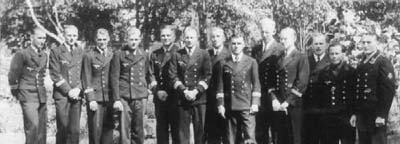|
The U - 33

Created: 25
March 2005

Cannock Chase
A few miles northwest of where
I live is Cannock in Staffordshire. Here there is a large tract of
wilderness known as The Chase. Contained within the Chase is a German Military
Cemetery and, within that cemetery, are the graves of 25 German sailors of the
Kriegsmarine U
boat Arm. They were members of the crew of the U Boat U-33. In February 1940 the
U-33 was deployed on a very hazardous mission to the Firth of Clyde, on the
west coast of Scotland, to lay mines. It would be only 5 miles from the Scottish
coast in a region heavily patrolled by the ships of the Royal Navy. The mission
was considered that dangerous that Admiral Doenitz himself came to see the U
Boat off and, on the previous night, the crew had been feted at a banquet in
their honour. The U-33 was a Type 7A boat of some 210 feet by 19 feet in
dimension. She weighed approx 500 tons. The crew of 40 - 45 men were cramped into a space of 142 x 10 feet, a
lot smaller than the outer dimensions! Conditions were abysmal to say the least.
Food tasted always of diesel fuel and the smell on the boat was atrocious. The
men could rarely wash and changes of clothing was infrequent. They only had one
usable toilet, the second being used as storage space. In no time at all the
smell from the usable toilet permeated throughout the small living space and was
particularly nauseating. To add to the discomfort, seawater would cascade down
the conning tower and heating was not a priority when considering fuel
conservation. Another danger, from a security aspect, was that codes and enigma
could fall into the hands of the enemy. Therefore minelaying missions, usually
close to shore, were not allowed to sail with the
enigma code machine or
its codes on board. Amidst all the euphoria of a visit from Admiral Doenitz this
had been forgotten on the U-33 and she slipped away from the dock with codes and
enigma intact AND on board. She would be operating in 35 - 40 metres of water.

Firth of Clyde, towards Holy Loch
During the early hours of 12th
February, the U-33 was approaching its chosen position, on the surface. Captain
Dresky wanted to be in position, then sit on the bottom, before dawn. Lookouts
spotted a silhouette moving towards them and a ship sailed on past in the dark,
it had not spotted them. Not long afterwards cries of "Alarm!" echoed throughout
the boat as lookouts reported a destroyer closing fast, heading straight towards
them. This was HMS Gleaner, an anti submarine converted survey ship. It was the
same ship that had just sailed past them. Nobody on board the ship had seen the
U Boat but an alert ASDIC operator had informed his Captain that he could hear
diesel engines, the captain turned to investigate/attack. The ship switched on
her searchlight and illuminated the silvery wake of the U Boats periscope as she
dived in an attempt to evade the Gleaner. ASDIC was firmly locked on target and
HMS Gleaner closed rapidly. Crewmen recalled later that depth charge after depth
charge hammered into the hull like massive detonations! Normally a U Boat could
dive deep to evade but here, in coastal waters, that luxury was not afforded.
The U -33 hit bottom on the 40 metre mark. Instrumentation was broken, machinery
inoperative and, worst of all, water was coming in through buckled steel plates.
Between 0400 hrs and 0500 hrs HMS Gleaner made 2 more attacks, dropping charges
accurately. They could not remain there and had to attempt to sneak away, but
U-33 was stuck on the seabed.

Little did the crew on the
U-33 know, but the last attack had crippled the Gleaner's ASDIC, she was blind!
The U-33 could have surfaced then submerged again, and made her escape. The only
way for the U-33 was up, at 0522 hrs the order was given to blow all tanks and
surface. Attempts to immediately scuttle the ship were thwarted by the need to
get the crew out safely. Fuses were lit, extinguished, then re-lit. The
Engineer, Schilling and The captain, Dresky, went back inside, then reappeared
after opening vents and resetting charges and Schilling was hurt when a large
explosion sent flame shooting up the conning tower into the night air, he had
been struck by the conning tower ladder. The U-33 then sank. Dresky made it into
the water but was not amongst those rescued. He had not been a particularly
popular Captain and had "dithered" in emergencies. 3 of the crew had
responsibilities to, if they had to abandon ship, to dispose of sets of wheels
for the Enigma code machine. 2 of the crew had done their duty and 6 wheels lay
on the sea bed. One, by the name of Friedrich Kumpf, disorientated and confused,
had not. Later on he confided to Heinz Rottmann, another survivor, that he had
not disposed of the wheels, his clothing was searched, nothing was found.
Rottmann rightly decided there and then that the British had found them.
However, later on, Schilling, the engineer who also survived, said that it was
he who had pulled Kampf from the sea onto a rescue trawler and his pockets had
been empty when he had removed the clothes from the sodden, freezing man. He
said Kampf was conscious but not in control of himself.

POW's in Canada. Schilling is seventh from the left.
Original
image from
http://www.u-35.com/crew/stamer.htm
However, what is clear is that
the British did indeed have three wheels and they had been handed to the Captain
by a rating who described them as "gear wheels from a bicycle". When the ship
docked, the wheels found their way to Bletchley Park and into the grateful hands
of Alan Turing and the cryptographers. With the inevitable passage of time,
memories become fazed and unclear, and some memories become intermingled with
imagination. This is not unusual, in fact quite normal. Obviously Schilling's
memories become confused with the passage of time as he could not have pulled
Kampf from the sea, but someone else, who he imagined to be Kampf. Whatever the
truth, due to the German Navy's forgetfulness in not removing the machine and
codes, the ASDIC operator on board HMS Gleaner who heard diesel engines and the
forgetfulness of a single crew member under stress, Britain now had three Enigma
wheels in her possession.

U33 was launched on 11 June 1936 and
commissioned on 15 July 1936.
Listed as Active Service from 1936
to its sinking on 12 Feb 1940 by Minesweeper HMS Gleaner in the
Firth of Clyde.
There were 17 survivors. 10 ships
sunk, total tonnage 19,261 GRT - 1 ship a total loss, total tonnage
3,670 GRT
http://uboat.net/wwi/boats/?boat=33
Enigma - Battle for The Code by Hugo Sebag-Montefiore
http://www.german-embassy.org.uk/remembrance_day_address_at_the.html

|